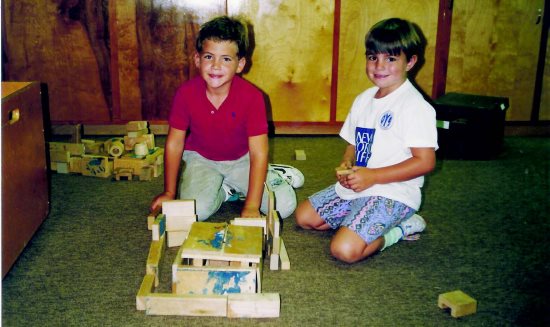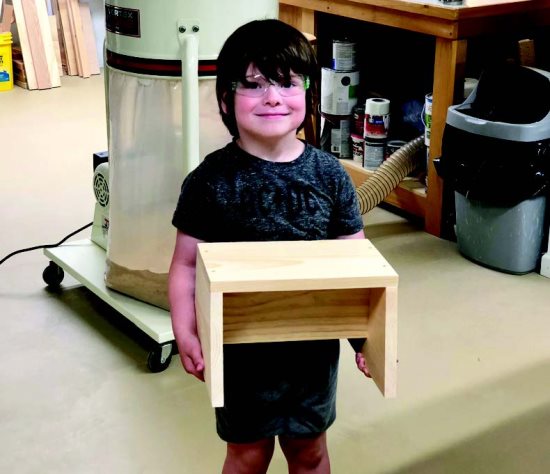| | Published June 27th, 2018
| Home projects for younger hands
| | | By Cathy Dausman |  | | Matt Talbot (left) with an early woodworking project. Photo provided |
Whether mom or dad is a casual carpenter, an entry-level electrician, avid gardener or a full-time builder/contractor, chances are they'll be enlisted for some honey-do projects at home. The challenge becomes not just completing a project, possibly one for the kids, but completing a project (and saving your sanity) with the kids. Here are some tips when smaller hands want to work big tool jobs.
 Safety first, cautions writer, editor, and woodworker A.J. Hamler. He specifies safety glasses, child-sized gloves and adequate protective clothing. "Eye protection is paramount," Hamler said, and child-sized safety glasses are inexpensive and easy to find online. He buys his in bulk in bright colors kids love. A small apron is good. An old adult shirt over the child's clothes will also work as long as it's not big and baggy, Hamler said.
Safety first, cautions writer, editor, and woodworker A.J. Hamler. He specifies safety glasses, child-sized gloves and adequate protective clothing. "Eye protection is paramount," Hamler said, and child-sized safety glasses are inexpensive and easy to find online. He buys his in bulk in bright colors kids love. A small apron is good. An old adult shirt over the child's clothes will also work as long as it's not big and baggy, Hamler said.
 Hamler says children are naturally drawn to interesting activities, new gadgets or tools and doing things adults do, and home projects involve all three. Just two things will make the project a success: visible signs of progress (sawdust, wood scraps, etc.) and a finished object. Recently Hamler helped his 5-year-old grandson build his own step stool. "Even though I did almost everything, in his mind his role was far more important."
Hamler says children are naturally drawn to interesting activities, new gadgets or tools and doing things adults do, and home projects involve all three. Just two things will make the project a success: visible signs of progress (sawdust, wood scraps, etc.) and a finished object. Recently Hamler helped his 5-year-old grandson build his own step stool. "Even though I did almost everything, in his mind his role was far more important."
 Concentrate fully on the task at hand, Hamler advises. Turn off the TV, shoo the dog outside, and don't allow other children to play in your work space. Stop the project, he says, if a child becomes nervous, frustrated, tired or distracted. And once you start a project never, ever take your eyes off your child, Hamler said. "If you need to leave the room, take them with you - don't leave them by themselves with tools you want to supervise," he cautioned.
Concentrate fully on the task at hand, Hamler advises. Turn off the TV, shoo the dog outside, and don't allow other children to play in your work space. Stop the project, he says, if a child becomes nervous, frustrated, tired or distracted. And once you start a project never, ever take your eyes off your child, Hamler said. "If you need to leave the room, take them with you - don't leave them by themselves with tools you want to supervise," he cautioned.
 Demolition is any child's dream job. It is often more fun than construction itself because making a mess is part of the process. If there's sheetrock to be torn out or cabinets to be ripped up, just watch the hands go up to volunteer. Again, give everyone plenty of safety gear, including sturdy closed-toe shoes so stray nails don't end up in someone's foot.
Demolition is any child's dream job. It is often more fun than construction itself because making a mess is part of the process. If there's sheetrock to be torn out or cabinets to be ripped up, just watch the hands go up to volunteer. Again, give everyone plenty of safety gear, including sturdy closed-toe shoes so stray nails don't end up in someone's foot.
 When the weather gets sunny invite kids to join in your gardening and landscaping projects. They've learned a thing or two from their Lamorinda schools, where all grade levels have tilled the earth. Students and their parents owe a debt of thanks to the nonprofit Moraga Gardens Farm (www.Moragagardensfarm.org). "When my kids were in Moraga schools the gardens didn't exist," said Claire Curtin, a 10-year MGF member and current board member. Curtin and fellow MGF member Betty Cooper are rightfully proud of their organization's role in supplying plants for what she calls "the next generation of home gardeners."
When the weather gets sunny invite kids to join in your gardening and landscaping projects. They've learned a thing or two from their Lamorinda schools, where all grade levels have tilled the earth. Students and their parents owe a debt of thanks to the nonprofit Moraga Gardens Farm (www.Moragagardensfarm.org). "When my kids were in Moraga schools the gardens didn't exist," said Claire Curtin, a 10-year MGF member and current board member. Curtin and fellow MGF member Betty Cooper are rightfully proud of their organization's role in supplying plants for what she calls "the next generation of home gardeners."
 "My boys have helped with our vegetable garden since they were little," said Cheryl Collins of Orinda. This past year they planted new drought-resistant plants. Collins says her sons disliked the weeding chores but loved planting and harvesting. "They especially loved playing rotten tomato baseball with a shovel," Collins said.
"My boys have helped with our vegetable garden since they were little," said Cheryl Collins of Orinda. This past year they planted new drought-resistant plants. Collins says her sons disliked the weeding chores but loved planting and harvesting. "They especially loved playing rotten tomato baseball with a shovel," Collins said.
 Three generations of the Lamorinda Talbot family have passed down a love of woodworking projects. Al Talbot's father, George, had a workbench "littered with miniscule parts for the latest wooden ship or boat model," recalled Al's wife, Lucy. She says Al's first apartment was filled with the end tables, stereo speakers and book cases he crafted in his spare time. Lucy and Al's son Matt picked up construction skills at age 5 by playing with a Brio MEC set. Later he built a cutting board and book shelves, and as a high schooler he rebuilt a service yard fence by himself as his father and grandpa looked on.
Three generations of the Lamorinda Talbot family have passed down a love of woodworking projects. Al Talbot's father, George, had a workbench "littered with miniscule parts for the latest wooden ship or boat model," recalled Al's wife, Lucy. She says Al's first apartment was filled with the end tables, stereo speakers and book cases he crafted in his spare time. Lucy and Al's son Matt picked up construction skills at age 5 by playing with a Brio MEC set. Later he built a cutting board and book shelves, and as a high schooler he rebuilt a service yard fence by himself as his father and grandpa looked on.
 Stanley Middle School Wood Tech instructor Michele Murphy says her students often try out their new skills at home. "Parents tell me that their son or daughter now will go into their workshop and start tinkering with the tools or ask to help them with their projects," Murphy said. Parents and grandparents often want to build a second Adirondack chair to match the one their eighth-grader built. Murphy says parents at open houses tell her over and over what a valuable skill woodworking was for their child to learn.
Stanley Middle School Wood Tech instructor Michele Murphy says her students often try out their new skills at home. "Parents tell me that their son or daughter now will go into their workshop and start tinkering with the tools or ask to help them with their projects," Murphy said. Parents and grandparents often want to build a second Adirondack chair to match the one their eighth-grader built. Murphy says parents at open houses tell her over and over what a valuable skill woodworking was for their child to learn.
 The community at large offers work projects suitable for children. Some big box hardware stores teach free projects aimed at the grade school set, (https://tinyurl.com/y9yloh65), and parents can learn woodworking skills alongside their children as young as age two at San Francisco's Butterfly Joint (http://thebutterflyjoint.com/). Classes are taught by owner Danny Montoya, a credentialed early-childhood educator.
The community at large offers work projects suitable for children. Some big box hardware stores teach free projects aimed at the grade school set, (https://tinyurl.com/y9yloh65), and parents can learn woodworking skills alongside their children as young as age two at San Francisco's Butterfly Joint (http://thebutterflyjoint.com/). Classes are taught by owner Danny Montoya, a credentialed early-childhood educator.
 Once they reach 16, teens can swing a hammer alongside their parents while volunteering at Habitat for Humanity (https://www.habitatebsv.org/get-involved). This bonding time combines learning construction skills with life lessons.
Once they reach 16, teens can swing a hammer alongside their parents while volunteering at Habitat for Humanity (https://www.habitatebsv.org/get-involved). This bonding time combines learning construction skills with life lessons.
 So, grab your tools, your offspring, and get to work! You'll be building lifelong memories, and possibly completing projects that will last nearly as long.
So, grab your tools, your offspring, and get to work! You'll be building lifelong memories, and possibly completing projects that will last nearly as long.
 Consult these websites before your home work begins:
Consult these websites before your home work begins:
 https://www.familyhandyman.com/tools/diy-for-kids/view-all/
https://www.familyhandyman.com/tools/diy-for-kids/view-all/
 https://www.bobvila.com/articles/kid-friendly-diy-projects/
https://www.bobvila.com/articles/kid-friendly-diy-projects/
 http://www.ajhamler.com/woodworking_gallery
http://www.ajhamler.com/woodworking_gallery


|
 | | A.J. Hamler's grandson is proud of the stepstool he made with his grandpa. | | | | | | | | | | | |





